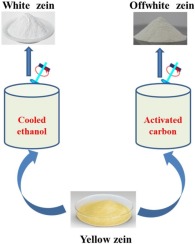当前位置:
X-MOL 学术
›
Colloids Surf. A Physicochem. Eng. Aspects
›
论文详情
Our official English website, www.x-mol.net, welcomes your
feedback! (Note: you will need to create a separate account there.)
Decolorization of commercial zein via protein precipitation involving organic solvents at low temperatures
Colloids and Surfaces A: Physicochemical and Engineering Aspects ( IF 4.9 ) Pub Date : 2020-07-01 , DOI: 10.1016/j.colsurfa.2020.124738 Jin Du , Jiachen Shi , Mohammed Obadi , Jihua Han , Yuntong Li , Jun Sun , Zhongwei Chen , Bin Xu
Colloids and Surfaces A: Physicochemical and Engineering Aspects ( IF 4.9 ) Pub Date : 2020-07-01 , DOI: 10.1016/j.colsurfa.2020.124738 Jin Du , Jiachen Shi , Mohammed Obadi , Jihua Han , Yuntong Li , Jun Sun , Zhongwei Chen , Bin Xu

|
Abstract The low-temperature organic solvent precipitation of proteins is a reversible denaturation process. In this study, the effect of the low-temperature precipitation decolorization of zein was investigated on the basis of this reversible process by using the pigment clearance rate and zein recovery rate as evaluation indicators. Low-temperature anhydrous ethanol was used as a precipitant. Furthermore, with the volume ratio of precipitator to zein solution (the volume ratio), precipitator temperature and zein solution pH as three factors. A low-temperature precipitation method was compared with an activated carbon adsorption method to determine the decolorization effect of zein via response surface methodology to optimize decolorization. Results showed that the decolorization effect of low-temperature precipitation was significantly affected by precipitator temperature, volume ratio, and zein solution pH. The primary order of their effects was as follows: precipitator temperature > volume ratio > zein solution pH. The decolorization effect of zein was optimal under the following parameters: precipitator temperature of −30 °C, zein solution pH of 6.8, and volume ratio of 2.5:1. Under these conditions, the zein recovery rate and the pigment clearance rate were 86.93 % and 98.72 %, respectively. By contrast, the zein recovery rate and the pigment clearance rate were 68.50 % and 79.22 % under the optimized activated carbon decolorization process, respectively. In conclusion, the effect of low-temperature precipitation decolorization and the recovery rate of zein were obviously better than those of activated carbon decolorization.
中文翻译:

在低温下通过有机溶剂的蛋白质沉淀使商业玉米蛋白脱色
摘要 蛋白质的低温有机溶剂沉淀是一个可逆的变性过程。本研究在此可逆过程的基础上,以色素清除率和玉米蛋白回收率为评价指标,研究了玉米蛋白低温沉淀脱色的效果。低温无水乙醇用作沉淀剂。此外,以沉淀剂与玉米蛋白溶液的体积比(体积比)、沉淀器温度和玉米蛋白溶液pH作为三个因素。将低温沉淀法与活性炭吸附法进行比较,通过响应面法确定玉米醇溶蛋白的脱色效果,优化脱色效果。结果表明,低温沉淀的脱色效果受沉淀温度、体积比和玉米蛋白溶液pH值的影响显着。其作用的主要顺序如下:沉淀器温度>体积比>玉米蛋白溶液pH值。玉米蛋白脱色效果在以下参数下最佳:沉淀器温度为-30°C,玉米蛋白溶液pH值为6.8,体积比为2.5:1。在这些条件下,玉米蛋白回收率和色素清除率分别为 86.93% 和 98.72%。相比之下,优化后的活性炭脱色工艺下玉米蛋白回收率和色素清除率分别为68.50%和79.22%。综上所述,
更新日期:2020-07-01
中文翻译:

在低温下通过有机溶剂的蛋白质沉淀使商业玉米蛋白脱色
摘要 蛋白质的低温有机溶剂沉淀是一个可逆的变性过程。本研究在此可逆过程的基础上,以色素清除率和玉米蛋白回收率为评价指标,研究了玉米蛋白低温沉淀脱色的效果。低温无水乙醇用作沉淀剂。此外,以沉淀剂与玉米蛋白溶液的体积比(体积比)、沉淀器温度和玉米蛋白溶液pH作为三个因素。将低温沉淀法与活性炭吸附法进行比较,通过响应面法确定玉米醇溶蛋白的脱色效果,优化脱色效果。结果表明,低温沉淀的脱色效果受沉淀温度、体积比和玉米蛋白溶液pH值的影响显着。其作用的主要顺序如下:沉淀器温度>体积比>玉米蛋白溶液pH值。玉米蛋白脱色效果在以下参数下最佳:沉淀器温度为-30°C,玉米蛋白溶液pH值为6.8,体积比为2.5:1。在这些条件下,玉米蛋白回收率和色素清除率分别为 86.93% 和 98.72%。相比之下,优化后的活性炭脱色工艺下玉米蛋白回收率和色素清除率分别为68.50%和79.22%。综上所述,











































 京公网安备 11010802027423号
京公网安备 11010802027423号